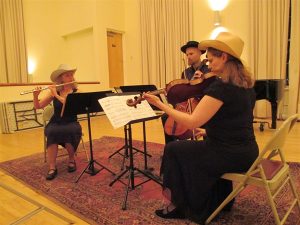January 14, 2014
This is the first of what I hope will be a fairly regular series of writings about composing, art and life from my perspective. While it will be my first foray into writing about my observations, I find that after more than 40 years of composing those thoughts continue to evolve, so I might as well share some of them.
How important is audience engagement in concert music performances? Judging by my recent experience, it’s more important than ever. My biggest musical events of 2013 occurred a little over a month ago, in Boston on December 7 and 8. That’s when A Far Cry , the absolutely splendid chamber orchestra, gave the premiere performances of Glimpses of Azure, a 20-minute four-movement work written for them. Although I’d known and loved their expert, high-energy, joyous approach to music making since their first season, it took six years for a commission to come together. It was worth the wait.
The December 7 performance took place at A Far Cry’s “home” venue, St. John’s Episcopal Church in Jamaica Plain. I knew I was in for something special as people started to arrive an hour early for the 4 p.m. concert. By 3:30 folks were streaming into the church in groups of six to ten, greeting each other happily. Clearly, this was a crowd out to enjoy themselves. And enjoy they did, despite being crowded into not just the main pews, but folding chairs set up in the back of the sanctuary as well as in the choir stalls behind the orchestra. I’ve never been to a concert where the audience was such a full participant in the experience, absolutely hushed during the music (despite the creaky, bare wooden pews) and then exploding into joyous applause thereafter. I’ve also never received so many compliments from total strangers, who told me how moved they were by my music. I felt part of a warm, engaged community, present to experience fully the musical gifts A Far Cry bestowed in return for total emotional and spiritual support. It was a peak experience.
The next afternoon the same program was presented as part of the Isabella Stewart Gardner Museum’s concert series. (A Far Cry is Chamber Ensemble in Residence at the Gardner.) The venue itself, a four-level glassed-in box with single rows of seats around each of the three balconies and a double row on the main floor where we sat, precluded the sort of intimate communal experience of the previous day. However, A Far Cry again performed beautifully and they and the music received warm applause and a fine review. I would call the experience more intellectual than emotional, in contrast to that of the day before.
I’ve given some thought to how different the two experiences were. In part, I think it was due to the venue itself. In Jamaica Plain we were all crowded together in a happy mass, while at the Gardner the layout of separate balconies with single rows worked against any feeling of commonality or togetherness in the audience. So why were the two audiences and my experiences so different? Both concerts were parts of series with a loyal following, and both feature A Far Cry on a regular basis. However, the St. John’s crowd obviously looked on the performers as “theirs” and listened raptly and with full emotional engagement, something I didn’t sense nearly as much from the Gardner audience.
Do I have any conclusions I draw from this? Yes, I do, and it has to do with the importance of audience members in the performance of concert music. I am used to committed listeners here in Vermont, and that goes for listening to new works as well as established pieces, so I have much more than two concerts from which to draw my experience. I think it behooves both composers and performers to work and reach out in new and also old ways to let laypeople know how important their participation is. If there’s one thing I had reinforced for me by these concerts, it was that the term “active listening” is not a contradiction in terms and it is something palpable. The days of performers merely showing up with or without a preceding reputation and letting the notes (both printed program and actual music) do the heavy lifting are over, if they ever existed. I’ve seen time and again that returning to a venue and establishing a rapport with listeners is vitally important for performers, as is their approach to the music.The more joy they feel and show in their playing, the more the audience will respond. As for us composers, we have a charge as well. For me music is not just a language, it’s a form of communication, and I work very hard, as many of us do, to reach the audience as directly as possible. We composers need to make sure we’re reaching out too, speaking to listeners with our music instead of just to ourselves or each other. Our compositions are our contribution to a sense of community and being as inclusive as possible is part of our vocation.

